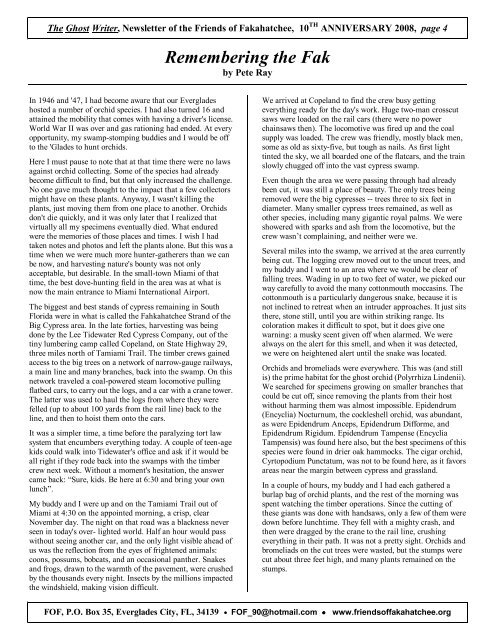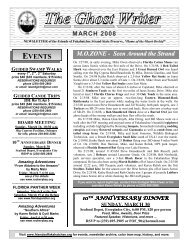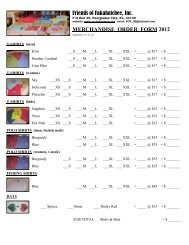The Ghost Writer - Friends of Fakahatchee
The Ghost Writer - Friends of Fakahatchee
The Ghost Writer - Friends of Fakahatchee
You also want an ePaper? Increase the reach of your titles
YUMPU automatically turns print PDFs into web optimized ePapers that Google loves.
<strong>The</strong> <strong>Ghost</strong> <strong>Writer</strong>, Newsletter <strong>of</strong> the <strong>Friends</strong> <strong>of</strong> <strong>Fakahatchee</strong>, 10 TH ANNIVERSARY 2008, page 4<br />
In 1946 and '47, I had become aware that our Everglades<br />
hosted a number <strong>of</strong> orchid species. I had also turned 16 and<br />
attained the mobility that comes with having a driver's license.<br />
World War II was over and gas rationing had ended. At every<br />
opportunity, my swamp-stomping buddies and I would be <strong>of</strong>f<br />
to the 'Glades to hunt orchids.<br />
Here I must pause to note that at that time there were no laws<br />
against orchid collecting. Some <strong>of</strong> the species had already<br />
become difficult to find, but that only increased the challenge.<br />
No one gave much thought to the impact that a few collectors<br />
might have on these plants. Anyway, I wasn't killing the<br />
plants, just moving them from one place to another. Orchids<br />
don't die quickly, and it was only later that I realized that<br />
virtually all my specimens eventually died. What endured<br />
were the memories <strong>of</strong> those places and times. I wish I had<br />
taken notes and photos and left the plants alone. But this was a<br />
time when we were much more hunter-gatherers than we can<br />
be now, and harvesting nature's bounty was not only<br />
acceptable, but desirable. In the small-town Miami <strong>of</strong> that<br />
time, the best dove-hunting field in the area was at what is<br />
now the main entrance to Miami International Airport.<br />
<strong>The</strong> biggest and best stands <strong>of</strong> cypress remaining in South<br />
Florida were in what is called the Fahkahatchee Strand <strong>of</strong> the<br />
Big Cypress area. In the late forties, harvesting was being<br />
done by the Lee Tidewater Red Cypress Company, out <strong>of</strong> the<br />
tiny lumbering camp called Copeland, on State Highway 29,<br />
three miles north <strong>of</strong> Tamiami Trail. <strong>The</strong> timber crews gained<br />
access to the big trees on a network <strong>of</strong> narrow-gauge railways,<br />
a main line and many branches, back into the swamp. On this<br />
network traveled a coal-powered steam locomotive pulling<br />
flatbed cars, to carry out the logs, and a car with a crane tower.<br />
<strong>The</strong> latter was used to haul the logs from where they were<br />
felled (up to about 100 yards from the rail line) back to the<br />
line, and then to hoist them onto the cars.<br />
It was a simpler time, a time before the paralyzing tort law<br />
system that encumbers everything today. A couple <strong>of</strong> teen-age<br />
kids could walk into Tidewater's <strong>of</strong>fice and ask if it would be<br />
all right if they rode back into the swamps with the timber<br />
crew next week. Without a moment's hesitation, the answer<br />
came back: “Sure, kids. Be here at 6:30 and bring your own<br />
lunch”.<br />
My buddy and I were up and on the Tamiami Trail out <strong>of</strong><br />
Miami at 4:30 on the appointed morning, a crisp, clear<br />
November day. <strong>The</strong> night on that road was a blackness never<br />
seen in today's over- lighted world. Half an hour would pass<br />
without seeing another car, and the only light visible ahead <strong>of</strong><br />
us was the reflection from the eyes <strong>of</strong> frightened animals:<br />
coons, possums, bobcats, and an occasional panther. Snakes<br />
and frogs, drawn to the warmth <strong>of</strong> the pavement, were crushed<br />
by the thousands every night. Insects by the millions impacted<br />
the windshield, making vision difficult.<br />
Remembering the Fak<br />
by Pete Ray<br />
We arrived at Copeland to find the crew busy getting<br />
everything ready for the day's work. Huge two-man crosscut<br />
saws were loaded on the rail cars (there were no power<br />
chainsaws then). <strong>The</strong> locomotive was fired up and the coal<br />
supply was loaded. <strong>The</strong> crew was friendly, mostly black men,<br />
some as old as sixty-five, but tough as nails. As first light<br />
tinted the sky, we all boarded one <strong>of</strong> the flatcars, and the train<br />
slowly chugged <strong>of</strong>f into the vast cypress swamp.<br />
Even though the area we were passing through had already<br />
been cut, it was still a place <strong>of</strong> beauty. <strong>The</strong> only trees being<br />
removed were the big cypresses -- trees three to six feet in<br />
diameter. Many smaller cypress trees remained, as well as<br />
other species, including many gigantic royal palms. We were<br />
showered with sparks and ash from the locomotive, but the<br />
crew wasn’t complaining, and neither were we.<br />
Several miles into the swamp, we arrived at the area currently<br />
being cut. <strong>The</strong> logging crew moved out to the uncut trees, and<br />
my buddy and I went to an area where we would be clear <strong>of</strong><br />
falling trees. Wading in up to two feet <strong>of</strong> water, we picked our<br />
way carefully to avoid the many cottonmouth moccasins. <strong>The</strong><br />
cottonmouth is a particularly dangerous snake, because it is<br />
not inclined to retreat when an intruder approaches. It just sits<br />
there, stone still, until you are within striking range. Its<br />
coloration makes it difficult to spot, but it does give one<br />
warning: a musky scent given <strong>of</strong>f when alarmed. We were<br />
always on the alert for this smell, and when it was detected,<br />
we were on heightened alert until the snake was located.<br />
Orchids and bromeliads were everywhere. This was (and still<br />
is) the prime habitat for the ghost orchid (Polyrrhiza Lindenii).<br />
We searched for specimens growing on smaller branches that<br />
could be cut <strong>of</strong>f, since removing the plants from their host<br />
without harming them was almost impossible. Epidendrum<br />
(Encyclia) Nocturnum, the cockleshell orchid, was abundant,<br />
as were Epidendrum Anceps, Epidendrum Difforme, and<br />
Epidendrum Rigidum. Epidendrum Tampense (Encyclia<br />
Tampensis) was found here also, but the best specimens <strong>of</strong> this<br />
species were found in drier oak hammocks. <strong>The</strong> cigar orchid,<br />
Cyrtopodium Punctatum, was not to be found here, as it favors<br />
areas near the margin between cypress and grassland.<br />
In a couple <strong>of</strong> hours, my buddy and I had each gathered a<br />
burlap bag <strong>of</strong> orchid plants, and the rest <strong>of</strong> the morning was<br />
spent watching the timber operations. Since the cutting <strong>of</strong><br />
these giants was done with handsaws, only a few <strong>of</strong> them were<br />
down before lunchtime. <strong>The</strong>y fell with a mighty crash, and<br />
then were dragged by the crane to the rail line, crushing<br />
everything in their path. It was not a pretty sight. Orchids and<br />
bromeliads on the cut trees were wasted, but the stumps were<br />
cut about three feet high, and many plants remained on the<br />
stumps.<br />
FOF, P.O. Box 35, Everglades City, FL, 34139 • FOF_90@hotmail.com • www.friends<strong>of</strong>fakahatchee.org





